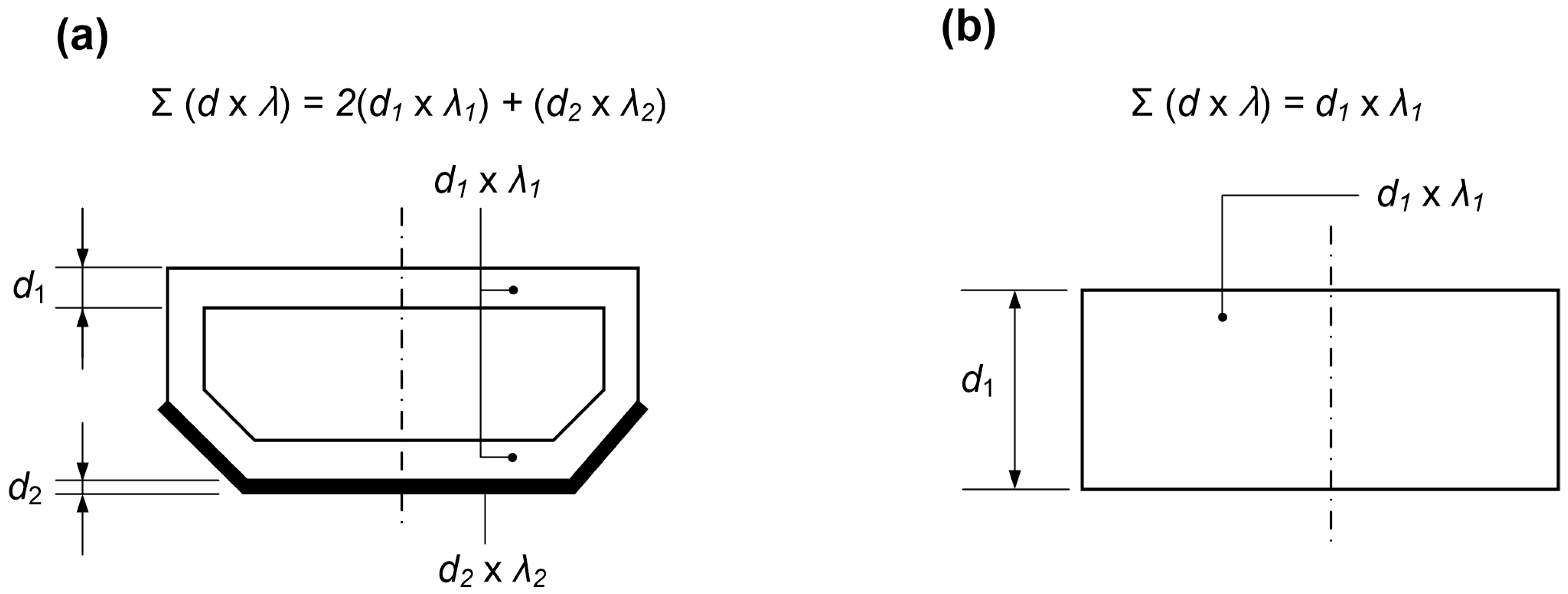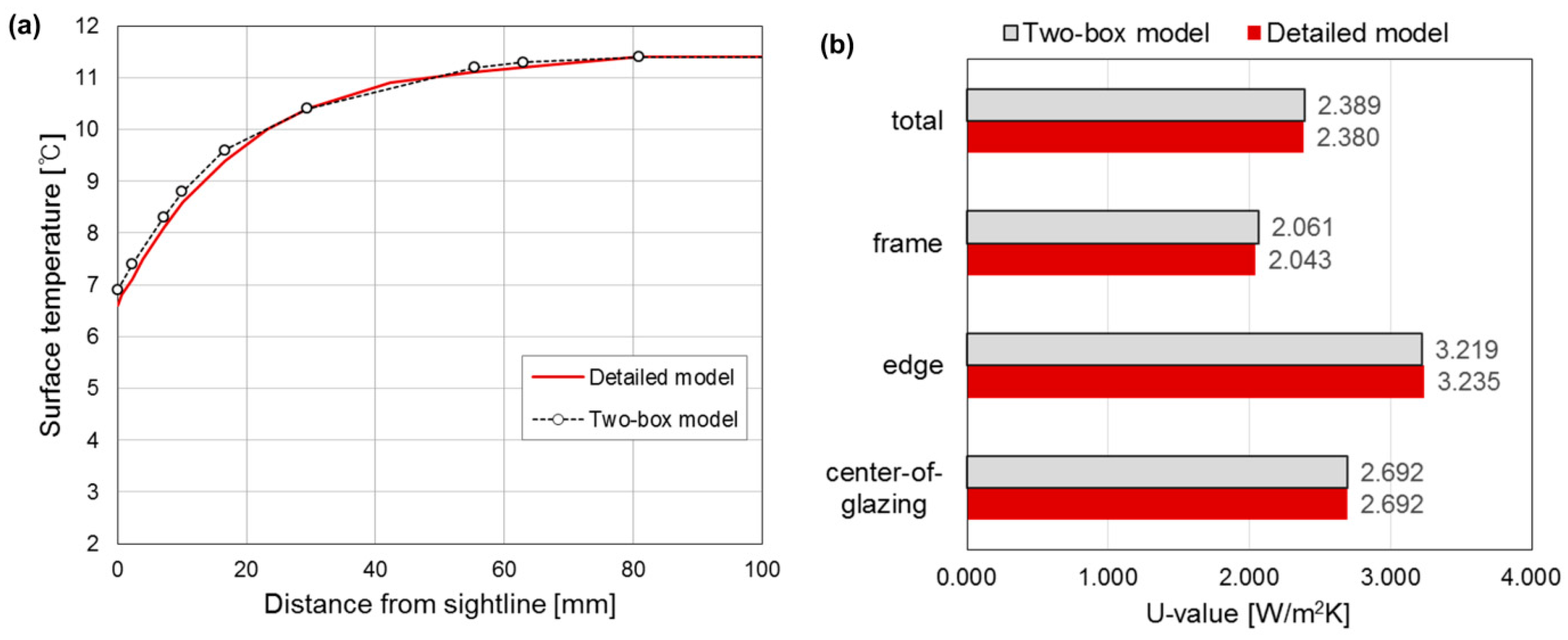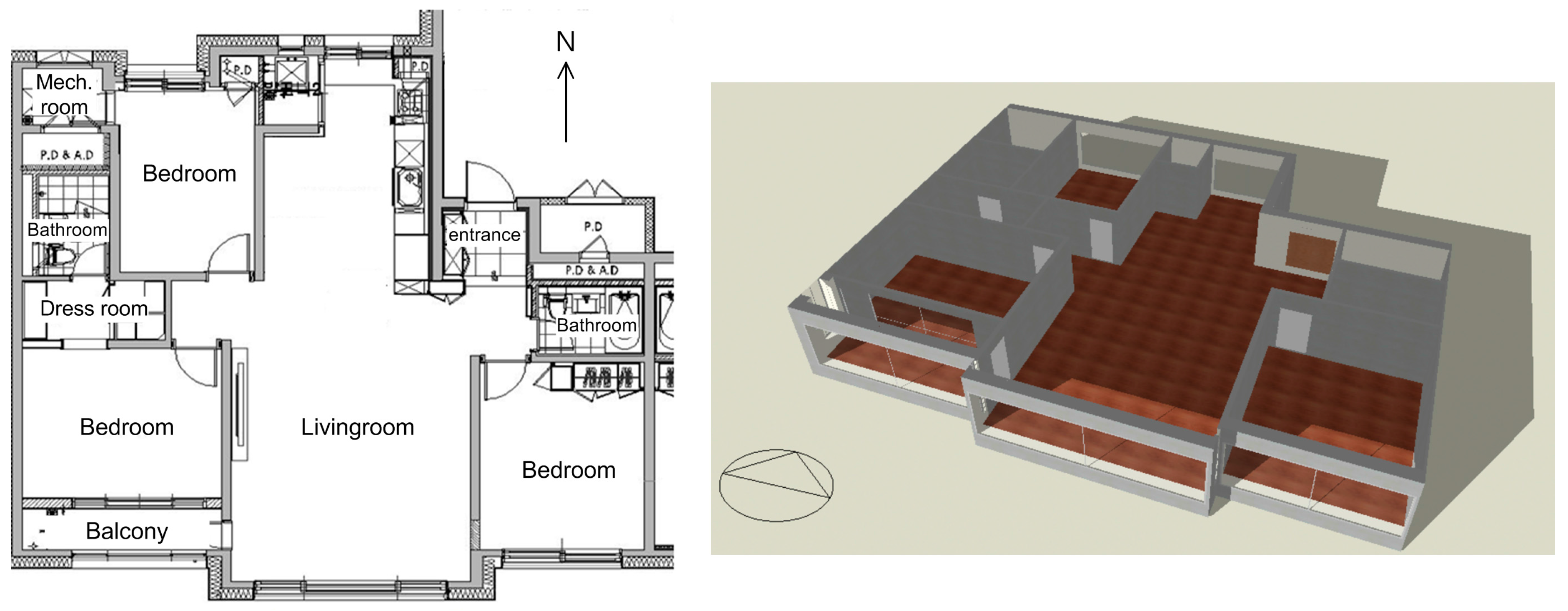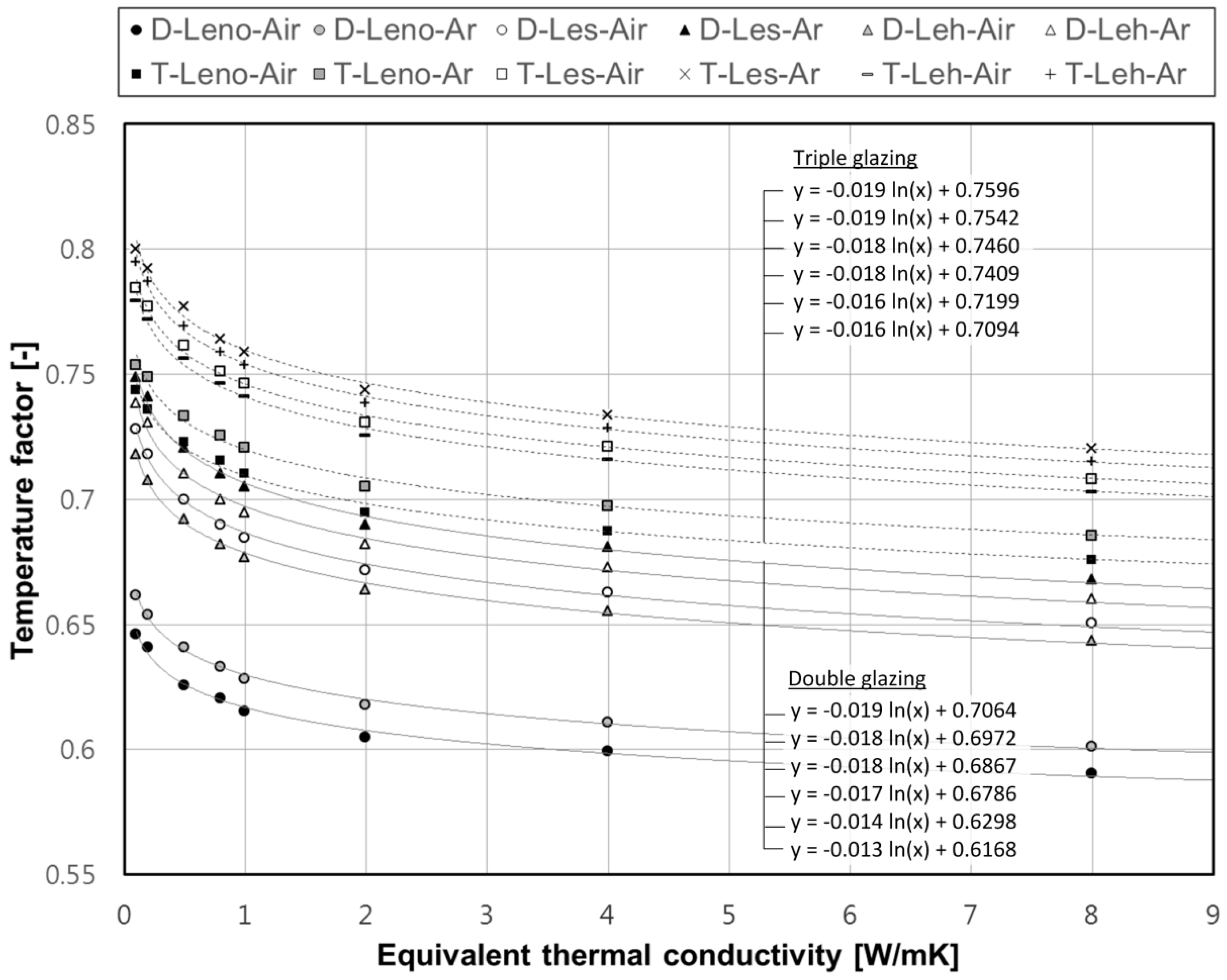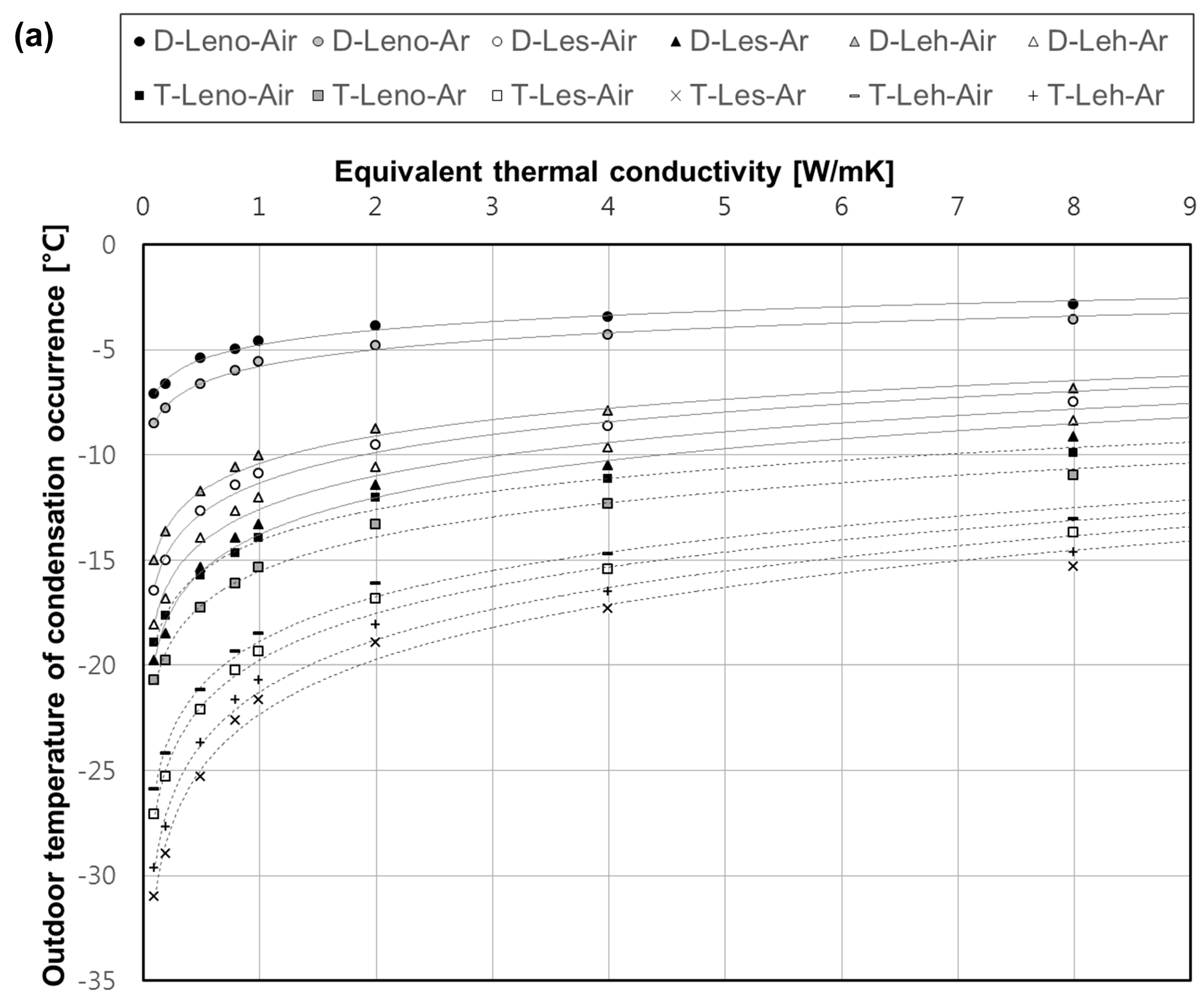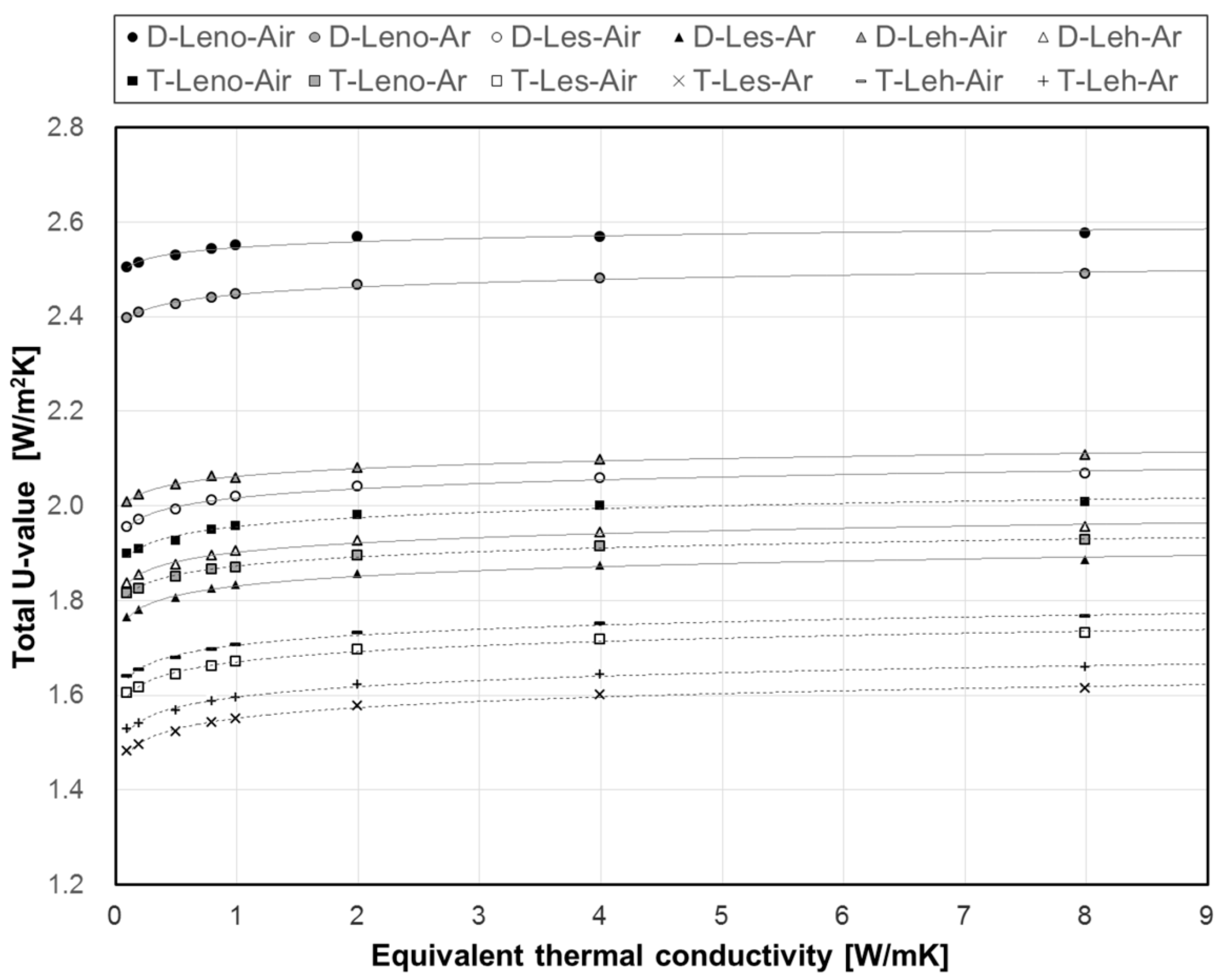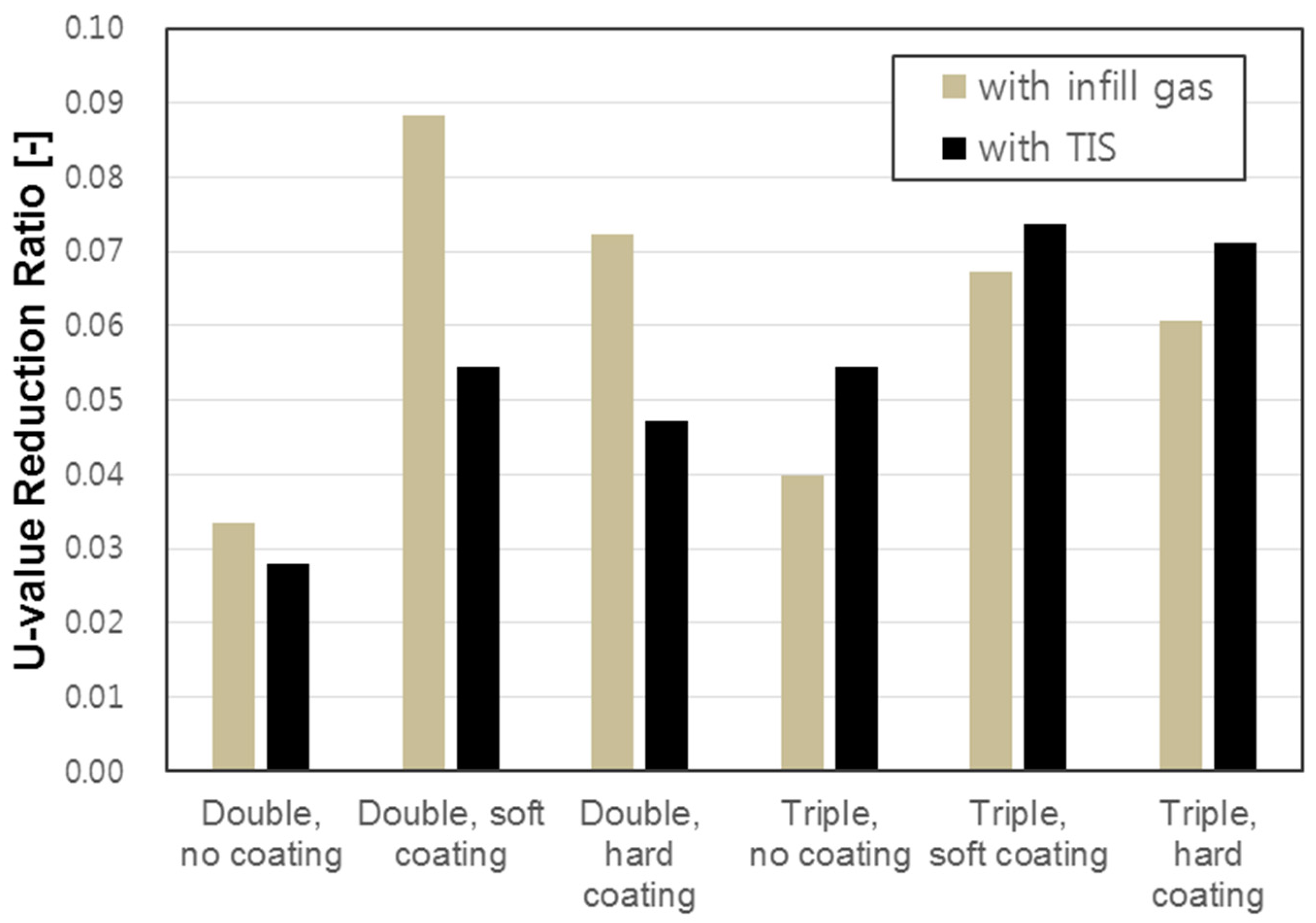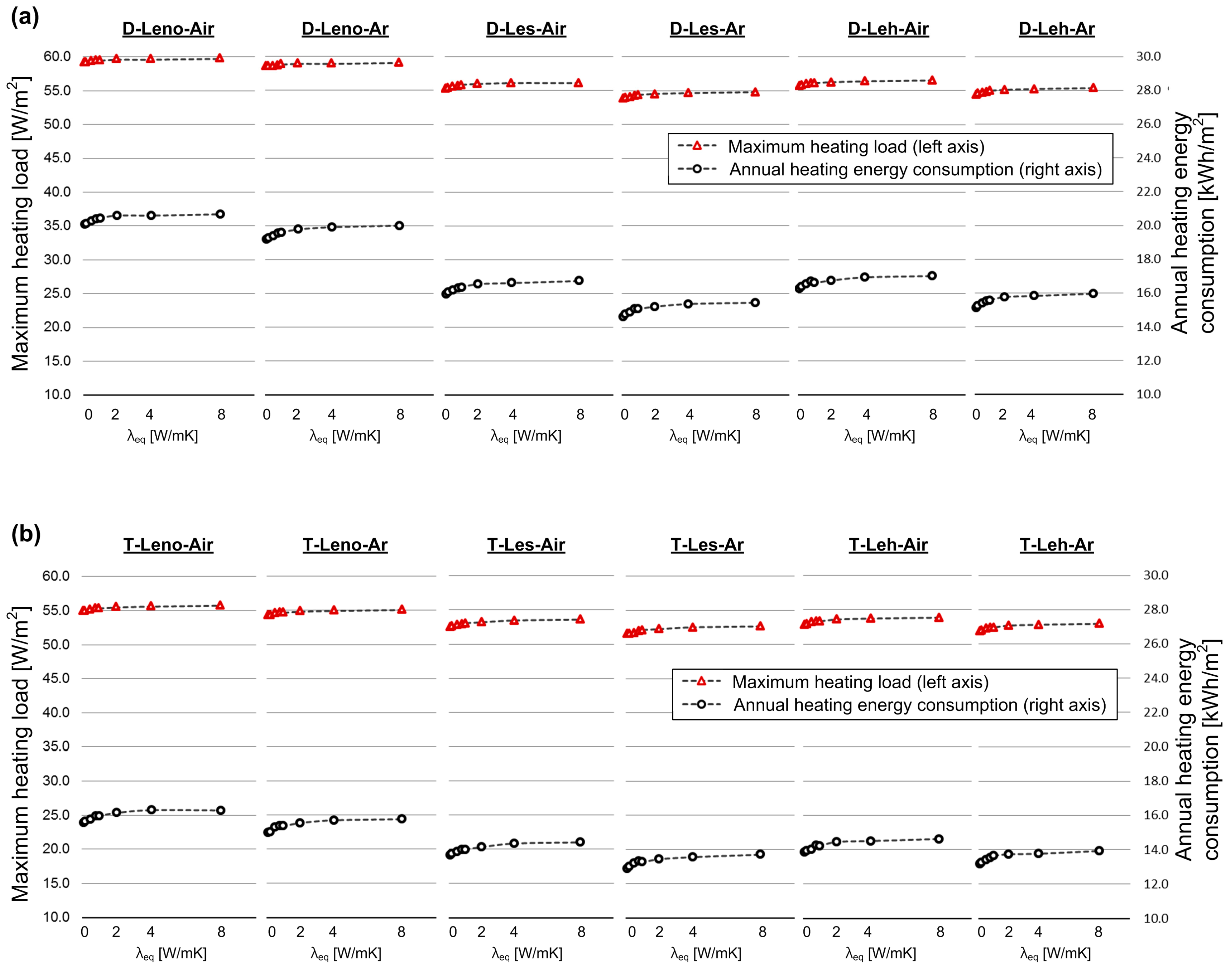1. Introduction
Windows are one of the weakest points in building envelopes from the viewpoint of the thermal insulation [
1,
2]. It is therefore important to enhance the thermal performances of windows to reduce the heat loss through windows, which can contribute to the reduction of not only condensation risks, but also the total heating energy of a building. In the window elements, the heat loss is particularly large at the edge region where thermal bridges can be created due to the adjoining frame and glazing. As thermal bridges usually result in increased heating/cooling load, condensation risks and the mould growth in the heating season [
3], the heat loss at the edge region should be minimized by applying highly-insulated window spacers, as well as high-performance glazing [
4].
In particular, residential buildings are prone to condensation risks due to the high moisture levels that are generated by the occupants’ respiration or activities [
5]. As the condensation can deteriorate not only the building durability but also occupants’ health, many studies have suggested methods to avoid the condensation; for example, insulative window spacers [
4], improved window frame using a material with low-thermal conductivity [
6], double window system with ventilation slits [
7], dynamic insulation windows using airflows [
8], and so on. As for the energy aspect, the energy regulations of low-energy residential buildings now demand a high-insulation performance regarding the building envelopes, which can be achieved by improving the thermal insulation and/or air-tightness of the windows [
9,
10,
11,
12,
13,
14,
15,
16].
Among the recent technologies for improving window performances, thermally improved spacers (TISs) are one of practical solutions to reduce the condensation risk and heat loss of insulated glazing units (IGUs) [
17]. The TISs are particularly effective to reduce the heat transfer through the edge region of the window. It should also be noted that the effect of the edge loss becomes more influential as windows are improved with low-e coatings and gas fills [
18]. The impact of the spacer on the heat loss and the surface condensation might be significant, especially in the cases of high-performance glazing units such as low-e-coated or gas-filled windows [
19]. As a result, the TIS technology has been increasingly applied to the IGUs of residential buildings [
4].
Elmahdy demonstrated that, relative to windows with conventional metal spacers, the TIS application results in higher surface temperatures at the edge-of-glass region, which improves the condensation resistance and the overall R-value [
20]. Carpenter and McGowan showed that the use of an insulating spacer can reduce the total U-value of a standard double-glazed wood-frame window by 6% compared with the traditional aluminium spacer [
21]. In addition, it was also reported that the application of the insulating spacer can reduce the total U-value of high-performance windows such as a double low-e-coated glazing by 12%. Song et al. evaluated the effect of two TIS types (thermally broken aluminium spacer and thick-walled plastic spacer) on the inside surface condensation in a double-glazing window system. It was claimed that the TISs increased the lowest inside surface temperature by up to 3.1 °C and the inside air humidity for the condensation prevention was increased by up to 11% compared with the conventional aluminum spacer [
4]. Gustavsen et al. showed that the changing of the effective spacer conductivity from 10 W/mK to 0.25 W/mK resulted in the reduction of the frame U-value by more than 18%. It was also claimed that a further reduction of the effective spacer conductivity—for example, 0.25 W/mK to 0.05 W/mK—can reduce the frame U-value and the edge-of-glass U-value by 10% and 8%, respectively [
1]. Baldinelli et al. demonstrated that, for a wooden window, the modification of the aluminum spacer with a warm spacer (plastic material) can reduce the total U-value by approximately 18% [
22].
Regarding the analysis methods for window spacers, Elmahdy and Frank conducted numerical and experimental studies to investigate the impact of four different spacers (aluminum spacer, corrugated metal spacer, silicone foam spacer, and thermally broken metal spacer) on the glass-surface temperature and the heat flow through the edge region. The discrepancy between the calculated and measured values is less than 4%, which led to a conclusion that the numerical simulation can be a very helpful tool in the provision of the data for simplified window-calculation procedures [
19]. Gustavsen et al. investigated the total U-value and the interior-surface temperature of windows with insulating spacers through numerical simulations and hot-box experiments; here, it was proved that the simulated thermal performances showed a sound agreement with the real measured results, even though the numerical simulations resulted in a larger difference of the total U-value between the traditional spacers and the insulating spacers [
23]. Based on the literature study, Maref et al. presented the following claims: The effect of the spacer should not be underestimated, the difference between different types of spacers is significant, and numerical simulations can be used to predict the effects of spacers [
24].
The previous studies mainly investigated the impact of the TIS on the heat transmittance or the indoor-surface temperature at the edge region. It was clearly shown that the TIS can contribute to the improvement of the thermal insulation or the condensation resistance. Only a few studies, however, have examined how the TIS affects both the condensation resistance and the total U-value. Also, there have been few examples of the TIS impact on the maximum heating load or annual heating energy consumption, because the thermal performance of the TIS was evaluated with regard to the total U-value. Moreover, in the current design process for windows, there is no rule of selecting a proper window spacer that can meet not only energy-saving regulation but also condensation prevention criteria.
Hence, this study investigated the reduction of the total U-value as well as the condensation risk with the application of the TIS. The relation between the total U-value and the condensation resistance was also analysed. In addition, the whole building energy simulation was conducted to evaluate the impact of the TIS on the maximum heating load and heating energy consumption. Based on the analysis, monographs for the window spacer determination were suggested so that a designer can consider not only condensation prevention but also the energy saving performance.
2. Survey of Window Spacers
The role of the window spacers is the provision of a cavity between multiple glasses for the purpose of improving the insulation performance of windows. The spacers need to provide a structural robustness to resist the thermal expansion and/or the contraction caused by the seasonal variations of outdoor-weather conditions. For this reason, they are usually made of rigid elements such as aluminum, steel, and non-metallic materials to provide the required structural strength.
As the metallic element of the spacer has high thermal conductivities, they can create an easy path for heat transfer through the edge region of windows. To decrease the heat transmittance through the spacer, it is necessary to reduce the thickness of the spacer elements or to apply non-metallic materials with a low thermal conductivity. Depending on the thickness and the thermal conductivity of the spacer materials, a window spacer can be classified as TIS if the summation of the thickness multiplied by the thermal conductivity at the central section is less than 0.007 W/K, as shown in
Figure 1 and Equation (1), as follows:
where
d is the thickness of the element perpendicular to the heat-transfer direction and
λ is the thermal conductivity of each element.
In this study, a literature survey was conducted to identify the window spacers that are currently available in the building industries [
1,
17,
26]. If a spacer meets the condition of Equation (1), it was classified as a TIS, as shown in
Table 1. The TIS is generally made of a very thin metallic part to compensate for the high thermal conductivity; alternatively, if the thickness of the element cannot be reduced, non-metallic materials such as plastic are inserted to increase the thermal resistance.
5. Conclusions
In this study, the impact of the window spacers on the total U-value and the temperature factor was numerically investigated with the THERM simulation. A two-box model was implemented for the simulation as it can facilitate the analysis of the complicated TIS with the acceptable accuracy. The whole building energy simulation was also conducted to quantify the impact of the spacers on the heating load and the annual heating-energy consumption. The simulation results showed that the employed thermally improved spacer (TIS) can increase the temperature factor by up to 12%, thereby resulting in a significant improvement of the condensation prevention performance. It was also shown that the employed TIS can reduce the total U-value by a quantity from 0.07 W/m2K to 0.13 W/m2K, implying that the reduction of the heat loss through the window is from 2.8% to 8.2%. The result of the whole building energy simulations proved that the TIS can reduce the maximum heating load by a rate from 0.9% to 2.1%, and it can save the heating-energy by up to a rate from 3.0% to 6.3%, depending on the window type.
Based on the results, monographs were proposed so that a designer can select an appropriate window spacer to comply with the design criteria regarding condensation prevention and energy saving performances. The results and the suggested monographs will help engineers, designers, and construction practitioners to improve the thermal performance of windows in terms of condensation prevention and heating energy saving.
For this study, a PVC frame was assumed in the analysis of the residential windows; however, the thermal properties such as total U-value and the temperature factor can vary according to the frame geometry and/or the material. Thus, the impacts of various frame types on the thermal performance need to be investigated to extend the applicability of the developed monographs. In addition, the simulation results and the developed monographs were derived from the meteorological data of Seoul. The results of this study can be applied to the similar climate zone; however, additional analysis should be performed in order to apply the determination monographs to other climatic contexts.
